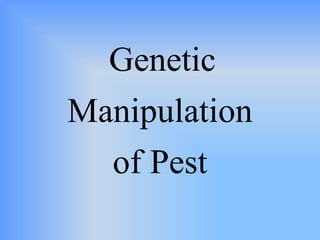
Genetic Manipulation of Pest
- 2. Genetic manipulation of Pest • Reduce the fitness of the pest directly, or indirectly in order to decrease or eradicate the population.
- 3. Sterile insect technique / release method (SIT) / (SIR) 1. Mass rearing of the target insect species (males) 2. Sterilizing the insects with ionizing radiation or chemosterilants. 3. Releasing in large enough numbers to reduce the probability of successful matings in the wild population
- 5. Edward F. Knipling • First described the SIT. • Best-known for his work to eradicate screwworm flies in Texas. Screwworms were eliminated in a span of only seven weeks, saving the domestic goat herds that were a source of meat and milk for the island people (1954)
- 7. • Screwworm fly (Cochliomyia hominivorax)- eradicated from the United States (1950s-90s), Netherland (Curaçao, 1954) and Libya (1990-92) • Mexican fruit fly (Anastrepha ludens) eradicated from most of northern Mexico. • Tsetse fly (Glossina morsitans) eradicated from Zanzibar (1970–1990s). • Sweet potato weevil (Cylas formicarius) eradicated from Kume Island, Okinawa, Japan (1994-99).
- 8. Sexier sterile insects • Giving the sterile males more sex appeal. • Prof. Boaz Yuval of the Hebrew University of Jerusalem’s of Robert H. Smith Faculty of Agriculture, Food and Environment noted the process of rearing millions of male insects, sterilizing them and transporting them to the release site can severely affect their sexual competitiveness, so he study the behavior and psychology of fruit flies and mosquito.
- 9. • Kills natural bacteria • Pseudomonas. • Breakfast of champion
- 10. Prof. Boaz Yuval
- 11. What are the limitation of SIT?
- 12. What are the limitations of SIT? • Geography. The eradication zone must have either natural barriers (e.g., oceans, deserts, mountains) or defensible borders to prevent or reduce the immigration of the target pest from outside.
- 13. What are the limitations of SIT? • Resistance . Native females may be able to recognize and refuse to mate with sterile males
- 14. What are the limitations of SIT? • Economics. Cost of rearing, sterilizing, and releasing a large numbers of insects can be very high and needs to be justified (EIL).
- 15. What are the limitations of SIT? • Desirability of sterile males. The lab-reared and sterilized males must be equally or more competitive than the native males in mating with the native females. They may become less desirable after many generations and need renewal.
- 16. What are the limitations of SIT? • Knowledge about the pest. reproductive behavior, population dynamics, dispersal, and ecology of the insect.
- 17. What are the limitations of SIT? • Timing. The development of the lab-reared colony must be synchronous with that of the wild population.
- 18. Inherited / delayed sterility • An alternative genetic strategy to SIT: – requires fewer insects – requires lower doses of radiation • Released insects are fertile but their progeny are sterile. • Genetic alterations induced by low dose radiation – Reciprocal translocations – genetic transformation with a conditional lethal trait
- 19. What are the advantages of SIT?
- 20. What are the advantages of SIT? • Creates inverse density-dependent feedback, making it more efficient as the wild population decreases.
- 21. What are the advantages of SIT? • The only PM tactic whose fundamental objective is to drive a wild population to extinction.
- 22. What are the advantages of SIT? • Specific
- 23. What are the advantages of SIT? • Environmentally-friendly – Does not contaminate natural food chain – No threat/harm to human health has so far been reported
- 24. Dominant Conditional Lethal Mutation Release of GM insects with dominant, conditional lethal trait
- 25. Thank you! COMMEND US!
Editor's Notes
- In theory, based on the K model, we can pretty much control any pest by releasing a large number of their sterile counterparts. But in practice SIT is not always very successful, can you think of some limitations with this method?
- Not all insect species can be reared in a laboratory in the numbers required for sterile insect release (SIR), and not all insect species can tolerate the levels of radiation necessary to sterilize them. "Inherited sterility" is an alternative genetic strategy that generally requires fewer insects to be reared and released and so may be economically feasible in situations where SIR is not. The impact of the reduced fertility of the translocation heterozygote on the overall population dynamics is somewhat uncertain and, no doubt, will depend on the species involved and its environment. In some cases it may be just enough to push the pest over the brink and into local extinction. But if there are compensating mechanisms, such as increased survival at later stages of development, halving the fertility may not provide satisfactory population suppression
- Inverse density-dependent: like a rolling snow ball. Unlike non-selective insecticide-based control, the SIT and other less known genetic pest control methods a re environmentally friendly. The induced sterility is dire c t e d exclusively at the target species and, contrary to other biological control methods, no adverse impacts on n o n - t a rget organisms have been re p o rted. It can be integrated with other conventional and biological methods, such as parasitoids, predators and insect pathogens (biopesticides). This integration enables the application of totally biological systems for managing some of the world's most important insect pests. SIT also exhibits increased efficiency with decre a s i n g t a rget population density. As a result it is the only e n v i ronmentally friendly technology available that can eradicate insect pests if applied consistently on an are
